We are extremely proud and excited to share with all of you the news that the Starboard iQFoil has been selected as the 2024 Olympic Equipment, replacing the RS:X equipment after the 2020 Olympic Games. The iQFoil concept is the fruit of many years of windsurf foiling equipment development, but developing the equipment to running a successful Olympic Campaign are two very different stories. The story of our iQFoil proposal has, above all, been one of great teamwork with a common goal of making the future of windsurfing more exciting and sustainable for the generations to come.
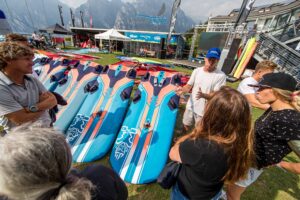
While big changes like this one are always daunting, it has been very encouraging to see especially some of the most successful RS:X sailors pushing to help bring about this Olympic windsurfing revolution.
The Olympics is the sporting pinnacle and the iQFoil project also goes beyond the Olympics. We’ve seen foil racing unite PWA racers, Formula Racers and Olympians. Next for us is to go mainstream.
With iQFoil equipment appealing and affordable not only to professionals but also the weekend windsurfer, our next goal will be to create a foil racing platform at the local level.
In the meantime, to get all of you as excited as we are about this change, we would like to introduce to you some of the key players of the iQFoil campaign and try to answer some of the questions you might have while we are at it.
Meet the People Behind the iQFoil:
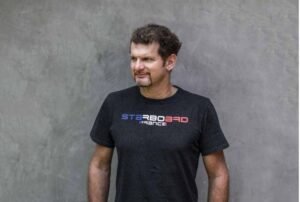
Remi Vila, you have campaigned and developed windsurfing equipment for the Olympics since 2002. As the chief designer of Starboard’s racing boards and the iFoil 95, you led the technical choices for the iQFoil package. You needed to achieve foiling from 6 knots while keeping the equipment as simple as possible. What were your ideas in selecting each item and what are their design highlights?
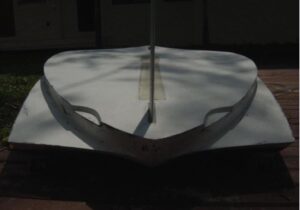 A prototype from Starboard’s 2002 Olympic Proposal.
A prototype from Starboard’s 2002 Olympic Proposal.
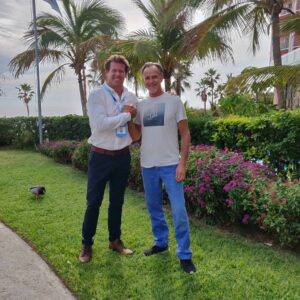 Gonzalo Costa Hoevel and Svein Rasmussen after the official announcement at the World Sailing Conference in Bermuda.
Gonzalo Costa Hoevel and Svein Rasmussen after the official announcement at the World Sailing Conference in Bermuda.
It’s been good fun to work with such an amazing project started by Tiesda You. The depth of this campaign goes beyond those who we usually hear about. When Sarah Kenny the Chair of the World Sailing Events Committee, spoke up on behalf of windsurfing at the World Sailing mid-year meeting in London, she created a chance for the sea trials to be held in Torbole. Dina Kowalyshyn, head of the equipment committee at World sailing was instrumental in persuading nations worldwide about her findings that the iQFoil concept being the best choice for the Olympics.
I would not have been here at Starboard today if it not for the co-inventor of windsurfing, Jim Drake, so cheers to Jim for having created Windsurfing in the way we know it, he would have been stoked to see us all fly. At times I felt in between “Mission Impossible” and “Groundhog Day” but with so many good spirits fighting for bringing Olympic windsurfing to the front line of our sport, it was in the cards that we underdogs could make it, as long as we are united. On behalf of our Tiki brand, I thank Jean Louis Colmas from New Caledonia, the creator of our Tiki spirit.
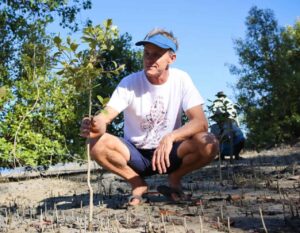
What is your message to all the young sailors who are just getting started with the RS:X or moving through the BiC Techno class?
I hope that RS:X riders will enjoy the transition to foiling and that the level of excitement will make the journey of windsurfing an even better one. Techno riders can keep on enjoying windsurfing and be sure that it’s only getting better as they grow into the Olympic class.
I ended my Olympic carrier in 1984 when we were told that we had to use div 2 boards for the next Olympics in 1988, that was after having been sailing the Windglider without a harness for 4 years. Now that we have cutting edge gear to ride in the following Olympic games it has never been a better time to get into competitive windsurfing.
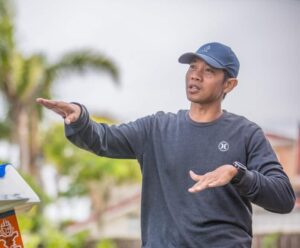
Tiesda You, you are the founder of Starboard Foils, brand manager for Starboard Windsurfing and the lead designer of the Starboard Race foil that made foiling in the Olympics a possibility. Having tried, tested and developed Starboard’s foiling equipment we would like to know: what is your favorite feature of the iQFoil Equipment?
Foiling is silent and smooth so it’s not physically pounding on your body. Yet from just 6 knots, you are already flying and racing. iQFoil is also easy by virtue of its simplicity: with one board, one sail, one boom, one foil, one fin, you can race with your friends every weekend or go for gold every quadrennial. There’s never been such a uniting opportunity in windsurfing so, in the long run, that’s the most exciting part about the iQFoil project. On a personal note, to see the Race foil win the PWA title, then the World Championships and eventually the 2024 gold medal will be immensely satisfying. Definitely a highlight of my design career.
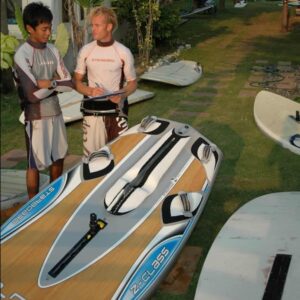 Tiesda You and Per Andersson developing Olympic board prototypes in Pattaya 2002.
Tiesda You and Per Andersson developing Olympic board prototypes in Pattaya 2002.
What is special about the iFoil foil?
The iQFoil foil is an upgraded version of the Starboard Race Plus. Like the Race Plus, it uses our patented High-Efficiency Foil Geometry, which means that the front wing is positioned further forward to allow the tail wing to run at a much more streamlined angle. Having both wings more aligned with each other gives you more speed and a lot more control in high winds. For light winds, there’s a tail wing angle adjustment system that allows you to increase tail wing angle, giving you extra power when you need it. It is also supplied with our new iQFoil 95cm mast, which is an extra-stiff version of the standard 95cm mast. It’s built from a fusion of 44 layers of ultra-high modulus carbon. It gives the highest level of control. As Remi mentioned, there are two fuselages in the box: the 115 Plus fuselage and the 95cm version. The iQFoil foil set is available in both Carbon and Aluminium versions, where the aluminum version is recommended for the Youth division.
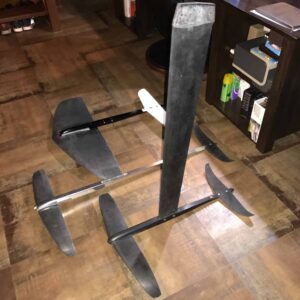 The first Race foil, with the breakthrough long fuselage concept and the upwind/downwind racing geometry: the founding concept that made foiling in the Olympics a possibility.
The first Race foil, with the breakthrough long fuselage concept and the upwind/downwind racing geometry: the founding concept that made foiling in the Olympics a possibility.
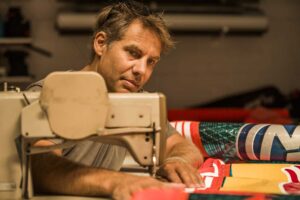
We’re stoked with the outcome of this project. It allows us to put on display the latest within windsurfing technology. And most importantly, give the Olympic windsurfers the tools to truly perform at their best with lightweight, responsive gear.
The HyperGlide series has been the dominant sail in foil racing with Gonzalo Costa Hoevel winning the 2018 World Title, and Matteo Iachino and Amado Vrieswijk all fighting for the 2019 world title.
We always design from a windsurfers perspective. With this background and knowledge base, we knew that an Olympic version would require significant improvements.
Firstly, we had to make sure the Hyper Glide Olympic would become the toughest weapon out there able to withstand countless hours of rigging, racing, and pumping. To ease the stress on the mast, the luff curve was reduced, and more reinforcements have been added making the sail capable of handling the biggest of loads. New XL cams help distribute the tension in the sail and improve the rotation.
User-friendliness was a focus point when we were writing up the design brief of this sail. Everyone agreed, that a sail like the HyperGlide Olympic should be light in the hands, responsive and allow for you to focus on your sailing for hours without wearing you out.
Ultimately, the final outcome was a sail with a redistributed shaping expanding the wind range and giving that lighter feel in the hands.
We’re excited to be following the development of the iFoil class!
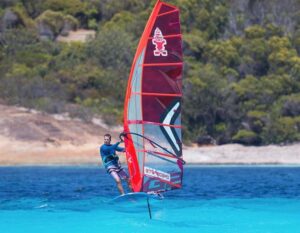
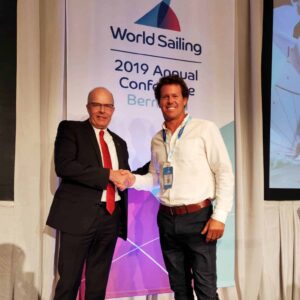 World Sailing President Kim Andersen and Gonzalo Costa Hoevel shake hands after a successful campaign in Bermuda.
World Sailing President Kim Andersen and Gonzalo Costa Hoevel shake hands after a successful campaign in Bermuda.

I’m very happy that we managed to put in a strong group effort to get foiling in. And I’m stoked that my letter made it possible for World Sailing to open up to look to new options and beyond the horizon of what they knew. So being part of all that was very nice. I’m glad I was able to help and push the sport in an exciting new direction.

Antonio Cozzolino, you’ve played an instrumental role in the iQFoil project since the early days and you were part of the team who took it over the finish line. Being an Olympic RS:X sailor, what has driven you to play such a prominent role in changing the future of Olympic windsurfing? What are your feelings after this new milestone and what is your message to all the RS:X sailors out there today?
Well first and foremost, foiling is really just a whole lot of fun. But then, we saw what the equipment could do. We saw its potential. The potential not only for the racing but more broadly what it could do for the sport, for participation, for growth and the opportunity it presented for spectacular media footage. And from that, came the vision. That vision has been the driving force behind everything we have done.
Being a current campaigning RS:X sailor offered a necessary perspective in terms of what would work and what wouldn’t. Part of what has lead me to be so prominently involved I guess is my day job! Commercial law is my background and this project involved assessing many competing considerations as well as the writing of many submissions. But what ultimately drove me to be so involved is simply that I believed in what we were doing.
I’m immensely proud of what we’ve done together in getting this through, it is phenomenal really. We will have changed windsurfing history in a positive way and that’s pretty special.
To the RS:X sailors? Well they’re all my friends, and most actually already do a lot of foiling anyway so they know the fun that lies ahead. But I want to thank them actually because the large majority supported this change and it is because of that that ultimately we were able to get this through. And to the ones who are still apprehensive, fear not, fun and exciting times to come!
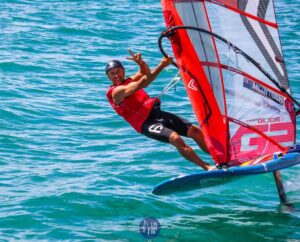
Hi Aaron Mcintosh, congratulations. You were a professional windsurfer up until 2001, involved with Americas Cup, Olympic Tornado Catamaran, Star Class, Etchell Class and currently the Olympic coach for the Netherlands, with back to back gold medals with Dorian van Rijesselberg. You inspired the project into motion, reaching out to Tiesda at Starboard to look at foiling in the Olympics on January 25 2018. What do you feel will be the impact of foiling on the Olympic Windsurfing community?
“If you want to predict the future, you create it”. We know we have reshaped the future of Olympic Windsurfing, it’s brought windsurfing back into the mainstream and made it cool again. The racing format will be challenging and dynamic for the sailors, engaging and exciting for media and public, we need that. It has ignited the Olympic dreams of so many more windsurfers and sailors to the class already. It’s all about the next generation of windsurfers – iQFoil is for them. It’s so exciting and the feedback already is inspiring.
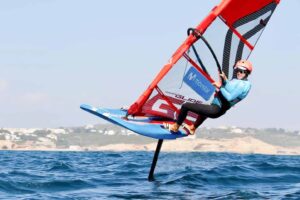
Marina Alabau, you are 5 x World Champion and Olympic Gold Medalist on the RS:X equipment but most recently we have seen you only foiling. How do you feel about the iQFoil becoming the New Olympic Class equipment?
I feel super excited about iQFoil equipment. I am so happy about this radical change in the Olympic class! It will be much better for all the sailors and the spectators so, in my opinion, it is a big step forward. As an athlete, it’s much more easy to sail, both in low wind and strong wind. The range, it’s as big as the RS:X but the riding is way easier. I am super happy because compared to the RS:X where the ideal weight range for girls was between 57 to 60 kg, the iQFoil will open the range much more. I just love it! I am very, very excited to see the foil in the Olympic community.
The IQFoil project is dedicated to Jim Drake and Per Andersson, two valuable contributors who helped us reach this milestone today.
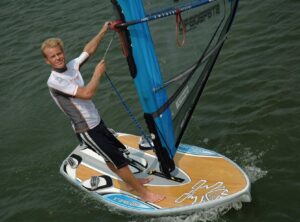
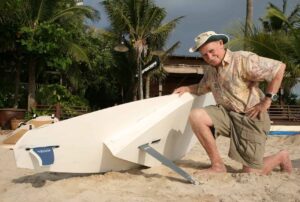


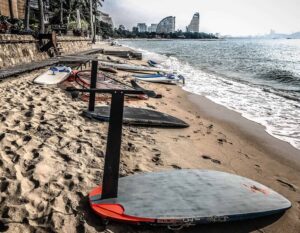 Visit Starboard Foils
Visit Starboard Foils




